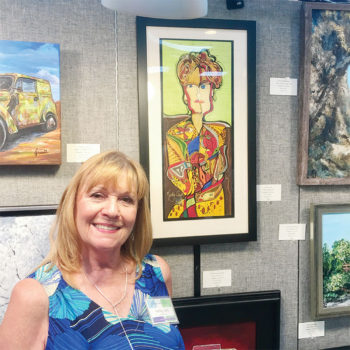 Marianne Graff
Marianne Graff
The PebbleCreek Art Club proudly presents acrylic artists and their paintings as a featured summer exposition. Although this medium is a “late bloomer” with relatively modest origins, nevertheless, acrylics’ impact on the art world has been enormous. This article is the first in a series and covers the origins of acrylic paint and important historical artists who have used this cutting-edge medium.
Acrylic paint is a comparatively modern medium. A German chemist named Otto Röhm invented an acrylic resin that was quickly transformed into acrylic paint. As early as 1934, the first usable acrylic resin dispersion was developed in Germany and patented by Röhm and Haas. The paint was first used in the 1940s, combining some of the properties of oil and watercolor. In the late 1940s, Leonard Bocour and Sam Golden came up with a spirit-based acrylic paint under the Magna brand and in the 1950s, acrylics became commercially available (Wikipedia).
Golden soon developed a water-based paint, Aquatec, and before long it was sold as latex house paint and for military vehicle use because the resin dried so quickly and adhered to almost anything. Artists became interested as well and, beginning in the 1950s, Liquitex sold water-soluble artists’ acrylic paints commercially. In 1963, Romney introduced artists’ acrylic paints in Europe and high viscosity artist quality paints soon became widely available (Wikipedia, Creative Connection).
Artists were quick to seize upon the possibilities of acrylics. In the 1920s and 1930s, Mexican muralists began experimenting with them. As early as 1936, the Mexican social realist muralist, David Alfaro Siqueiros experimented with the medium (see Echo of a Scream, 1937, ARTmine). Soon other artists began their own trials including Jackson Pollock and WPA muralists. After Magna paints became available, well-known artists such as Mark Rothko, Kenneth Noland and Roy Lichtenstein painted with acrylic. Then in the mid-1950s, just when water-based acrylics became commercially available, movements like pop art, abstract expressionism and photorealism burst upon the scene. Acrylic paint was proving very beneficial to artists looking for faster drying times, flexibility, vivid color and versatility. American artists such as Andy Warhol, Robert Motherwell and Helen Frankenthaler, and British artists like Bridget Riley and David Hockney were also attracted to the acrylic medium (ARTmine). Acrylics enabled Bridget Riley to achieve creative milestones with her line structures and tonal studies in abstract language (see Zing 1). Burying her images inside contractions of geometric shapes and juxtapositions of colors, her bands of lines and hues became lively rhythms rising and falling and offering the viewer challenging visual encounters with her work.
You are challenged in turn to become familiar with these artists and discover how they used acrylic paint to forge new vistas, to create “a way forward into uncharted but exciting territory” (Artists network). These vistas are still being explored today: PebbleCreek artist Kathy Sork’s work and that of other artists can be viewed in the Creative Arts Center and the Tuscany Falls and Eagle’s Nest Clubhouses.
